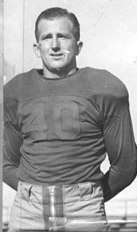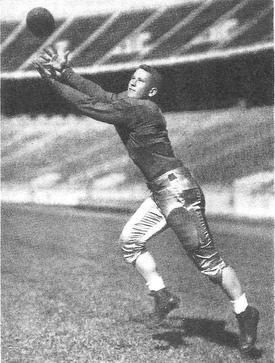Related Research Articles

Sidney P. Wagner was an American college and professional football player who was a lineman for the Michigan State Spartans football team of Michigan State University and the Detroit Lions of the National Football League (NFL). Wagner was a consensus All-American in 1935.

Edwin Clarence Widseth was an American professional football player who was a tackle for the New York Giants of the National Football League (NFL) for four seasons. He played college football for the Minnesota Golden Gophers football team of the University of Minnesota, where he was a consensus All-American in 1935 and 1936. Widseth was drafted by the New York Giants in the first round of the 1937 NFL draft, and was chosen for the Pro Bowl in 1938. He was later inducted into the College Football Hall of Fame.

Gaynell Charles "Gus" Tinsley was an American football end and coach. He played for the Chicago Cardinals of the National Football League (NFL) from 1937 to 1938 and in 1940. He played college football for the LSU Tigers, where he was a consensus All-American. He was drafted in the second round of the 1937 NFL Draft by the Cardinals, with whom he was an All-NFL selection in 1937 and 1938. During his three years in the NFL, Tinsley set or tied NFL single-season records with 674 receiving yards in 1937 and 41 pass receptions in 1938. He later served as the head football coach at LSU from 1948 to 1954. He was inducted into the College Football Hall of Fame in 1956 as a player.
Robert Edward Wilson Jr. was an American football player. He attended Southern Methodist University (SMU), where he played halfback for the SMU Mustangs football team from 1933 to 1935. He was recognized as a consensus first-team All-American following his 1935 senior season. Wilson was chosen by the National Football League (NFL)'s Brooklyn Dodgers in fifth round in the 1936 NFL draft, and played a single season for the Dodgers in 1936. Wilson was inducted into the College Football Hall of Fame in 1973, and died in 1999.

The SMU Mustangs are the athletic teams that represent Southern Methodist University in University Park, Texas, United States. SMU was founded in 1911 and joined the Southwest Conference, competing against Baylor, Rice, Texas, Texas A&M, Arkansas and Oklahoma A&M.

Charles P. Beasley was an American basketball player. Beasley played college basketball for the SMU Mustangs. He played professionally in the ABA for the Dallas Chaparrals and The Floridians.

The SMU Mustangs football program is a college football team representing Southern Methodist University (SMU) in University Park in Dallas County, Texas. The Mustangs compete in the NCAA Football Bowl Subdivision (FBS) as a member of the Atlantic Coast Conference (ACC). SMU joined the ACC in July 2024 after 11 years as a member of the American Athletic Conference.
The 1935 college football season was the last one before the Associated Press (AP) writers' poll was used in selecting the national champion. There were seven contemporary math system selectors that year who are informally recognized by the NCAA as "nationwide in scope". The Dickinson System, run by University of Illinois Professor Frank Dickinson, selected Southern Methodist University (SMU) as best in the nation. The Houlgate System, created by Carroll Everard "Deke" Houlgate Sr., also selected SMU. The contemporary Boand, Litkenhous and Poling math rating systems all selected Minnesota as the No. 1 team in the nation. The Dunkel System selected Princeton as its top team. The Williamson System, by Paul O. Williamson of New Orleans, ranked Texas Christian University first.
The 1935 College Football All-America team is composed of college football players who were selected as All-Americans by various organizations and writers that chose College Football All-America Teams in 1935. The nine selectors recognized by the NCAA as "official" for the 1935 season are (1) Collier's Weekly, as selected by Grantland Rice, (2) the Associated Press (AP), (3) the United Press (UP), (4) the All-America Board (AAB), (5) the International News Service (INS), (6) Liberty magazine, (7) the Newspaper Enterprise Association (NEA), (8) the North American Newspaper Alliance (NANA), and (9) the Sporting News (SN).

Jesse Claude "Iron Man" Wetsel was an American college football player for the SMU Mustangs football team of Southern Methodist University in the 1930s. He was a consensus All-American at the guard position in 1935.

Merle Wendt was an All-American football player at Ohio State University. Wendt played at the end position and became the fourth three-time All-American (1934–1936) at Ohio State, following Chic Harley, Wes Fesler, and Lew Hinchman.
William Inwood Smith was an All-American football player for the Ohio State University Buckeyes in the mid-1930s. He was drafted in the fifth round of the 1937 NFL Draft. A native of New Jersey, he moved with his family to Mansfield, Ohio as a boy. In addition to football, Smith was a competitive swimmer, basketball player, and track and field athlete. At the end of the 1935 college football season, Smith was selected as a first-team All-American by Grantland Rice for Collier's Weekly and by a board of coaches for Pathé News. After graduating from Ohio State, Smith was employed by the Westinghouse Electric Manufacturing Co. in Grand Rapids, Michigan, and Cleveland. During World War II, Smith became district supervisor of the Office of Price Administration in Columbus, Ohio.

The SMU Mustangs men's basketball team represents Southern Methodist University (SMU) in University Park, Texas and currently competes in the American Athletic Conference of NCAA Division I college basketball. In 104 years of basketball, SMU's record is 1,377–1,237. SMU has reached one Final Four, made 12 NCAA Tournament Appearances, won 16 Conference Championships, had 11 All-Americans, and 23 NBA Draft selections.
The 1947 SMU Mustangs football team was an American football team that represented Southern Methodist University (SMU) as a member of the Southwest Conference (SWC) during the 1947 college football season. In its tenth season under head coach Matty Bell, the team compiled a 9–0–2 record, won the SWC championship, outscored opponents by a total of 182 to 90, and was ranked No. 3 in the final AP Poll. The team played its home games at Ownby Stadium on the SMU campus and at the Cotton Bowl in Dallas.

Cole Dickson Beasley is an American football wide receiver who is a free agent. He played college football at Southern Methodist University and was signed by the Dallas Cowboys as an undrafted free agent in 2012. He also played three seasons for the Buffalo Bills before retiring with the Tampa Bay Buccaneers in 2022. He came out of retirement a few months later in the season to re-sign with the Bills.
The 1935 SMU Mustangs football team was an American football team that represented Southern Methodist University (SMU) in the Southwest Conference (SWC) during the 1935 college football season. In their first season under head coach Matty Bell, the Mustangs posted an overall record of 12–1 record with a mark of 6–0 in conference play, winning the SWC title. SMU was invited to the Rose Bowl, where they lost to Stanford. The Mustangs shut out eight of thirteen opponents and outscored all opponents by a total of 288 to 39 on the season.
The 1946 SMU Mustangs football team was an American football team that represented Southern Methodist University (SMU) as a member of the Southwest Conference (SWC) during the 1946 college football season. In their ninth season under head coach Matty Bell, the Mustangs compiled a 4–5–1 record and outscored opponents by a total of 114 to 100.
The 1935 SMU vs. TCU football game was a regular season college football game between the SMU Mustangs and the TCU Horned Frogs on November 30, 1935, at Amon G. Carter Stadium in Fort Worth, Texas. The two teams were undefeated and untied heading into the game. Both Southern Methodist University and Texas Christian University were members of the Southwest Conference, and a win in this game was necessary for either team to secure the conference championship. The game also held national championship implications, as the winner was expected to receive an invitation to compete in the Rose Bowl. As a result, the game is commonly considered the "Game of the Century", a moniker which noted sportswriter Grantland Rice, among others, used to describe the game. The buildup attracted a great deal of national attention, and it was the first football game in Texas to be broadcast nationwide on radio.
References
- ↑ "Inwood Smith Selected For Collier's 'American: Ohio State Guard One of Three Middlewestern Players Honored; Year Termed 'Greatest'". Circleville Herald. December 12, 1935.
- ↑ "Inwood Smith on Pathe All-America". Mansfield News Journal. December 9, 1935.
- ↑ Alan Gould (December 7, 1935). "Southwest Conference Lands Two Men on All-America: Lester and Wilson Make First Eleven; McCauley, Spain Placed on Second Team; Baugh, Wallace on Third". Galveston Daily News.
- ↑ Jack Singer (December 22, 1935). "Real All-American of 1935 Season Selected". Los Angeles Times.(The Consensus All-American team was based on the following scoring system: 5 points for a first-team selection; 3 points for a second-team selection; and 1 point for a third-team selection. The All-American teams reviewed for the consensus team were AP, UP, INS, NEA, North American Newspaper Alliance, All-America Board, Collier's, Bill Corum's symposium, and Fritz Crisler.)
- 1 2 "If Movie Colony Grabs Off One Of Mustangs, It Likely Will Be Clark Gable Spain". Abilene Daily Reporter. December 13, 1935.
- ↑ Tom Beasley (December 27, 1935). "Matty Bell Says His Mustangs in Tip-Top Condition: Autograph Seekers Swamp Coach; Spain is Center of Attention". Big Spring Daily Herald.
- ↑ "Tom Beasley Around And About The Sports Circuit". Big Spring Daily Herald. January 30, 1936.
- ↑ "1936 NFL Draft Listing". Pro-Football-Reference.com. Retrieved March 20, 2023.
- 1 2 "SMU Grid Hero Dies in McLean". Amarillo Globe-Times. February 13, 1968.